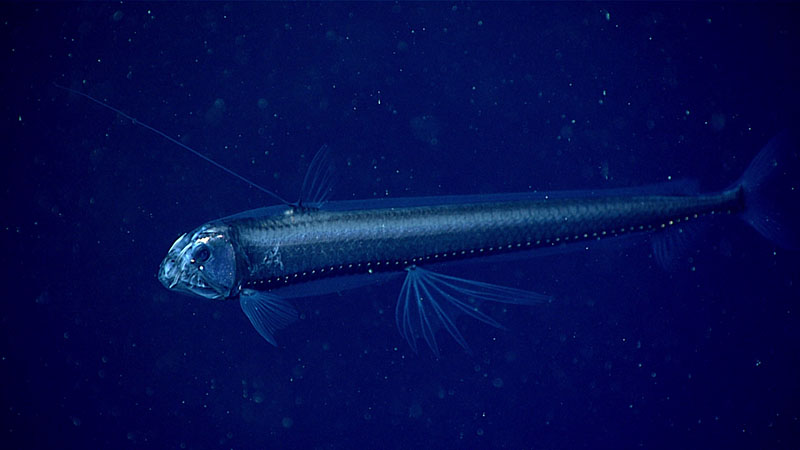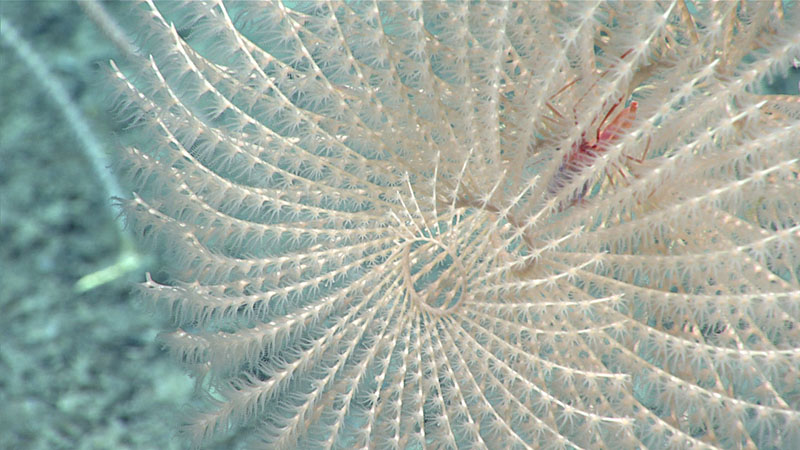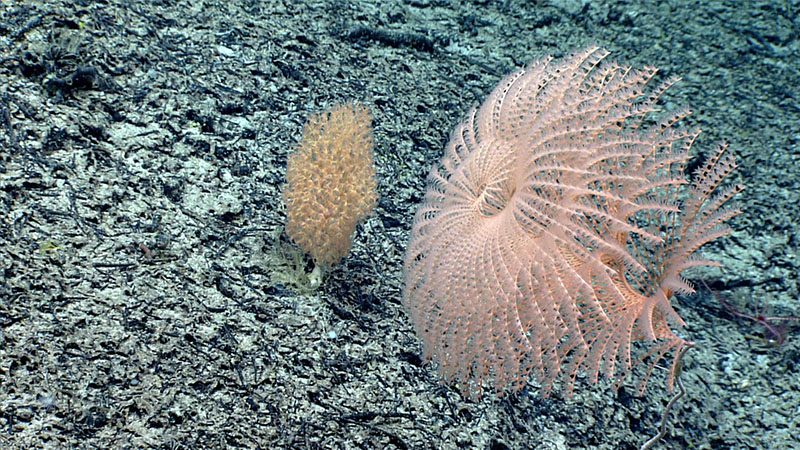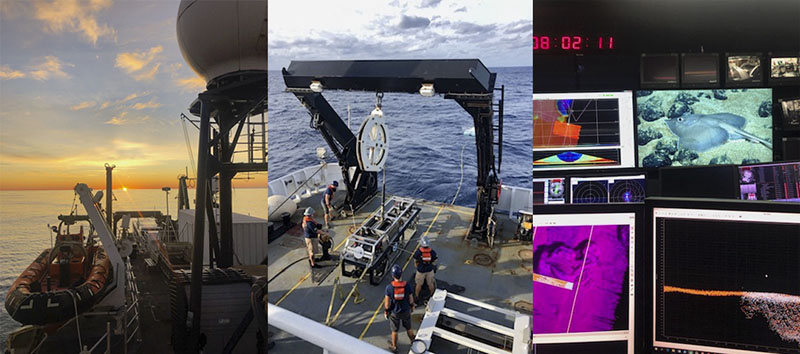
At NOAA Ocean Exploration, a core part of our mission is engaging the next generation of ocean explorers through internships. Each cohort of interns brings unique perspectives and new ideas that advance our office’s operations in meaningful ways. These students come from diverse backgrounds such as communications, marine biology, engineering, geology, mapping, and more, but they share an enthusiasm for learning about our ocean world. As we celebrate National Intern Day 2021, get to know some of this year’s interns below!
Quinn is a rising senior at Juniata College, studying biology. After graduating, she plans to pursue a doctoral degree in marine biology. As a NOAA Hollings Scholar with NOAA Ocean Exploration, she is investigating organism occurrence in the Gulf Stream and deep scattering layer (DSL). The data she is working with comes from three NOAA expeditions from 2018 and 2019, where imagery, environmental (CTD), and acoustic data were collected from NOAA Ship Okeanos Explorer and remotely operated vehicles Deep Discoverer and Seirios. Satellite-derived current data were also incorporated for Gulf Stream comparisons. To conduct this research, Quinn is using a variety of programs, including R, SeaTube, Echoview, and ArcGIS. She would like to thank her mentors at NOAA, the Hollings Scholarship team, and her professors for this amazing opportunity.
“What I love about this research is the interdisciplinary nature of it as well as being able to learn new techniques that I wouldn’t have been exposed to otherwise. Additionally, relatively little is known about the organisms I'm working with, which is very exciting because of the discovery aspect.”
During the 2021 ROV Shakedown and 2021 North Atlantic Stepping Stones expedition, she participated as a scientist from shore and helped annotate the live water column dives. Her favorite part of this role is seeing the organisms in real time and not knowing which species we’ll see next.

This viperfish, imaged during the 700-meter (2,297-foot) transect to explore the water column above Hydrographer Canyon during Dive 20 of the 2021 North Atlantic Stepping Stones expedition, was a highlight from the expedition for NOAA Hollings Scholar Quinn Girasek. Image courtesy of NOAA Ocean Exploration, 2021 North Atlantic Stepping Stones: New England and Corner Rise Seamounts. Download largest version (jpg, 894 KB).
Noelle is a recent graduate of the University of Alberta where she completed her master’s degree in ecology, mapping shallow tropical reefs in the Caribbean. This summer, as an Explorer-in-Training with NOAA Ocean Exploration, Noelle is getting a behind-the-scenes look at what it takes to make deep-sea expeditions happen, from the earliest planning phases to real-time expedition action to understanding where the data goes afterwards. Her main project focuses on identifying exploration priorities for the southeast Atlantic region. She is using GIS to build an expedition planning map for an expedition this coming fall by assimilating a variety of data, including layers such as seafloor bathymetry, known deep-sea species distributions, and previous expedition locations. She is also building a heatmap of all previous deep-sea submersible dive locations that she will use to propose remotely operated vehicle dive sites during the fall expedition. To help understand the office’s contributions to Atlantic exploration, she is also writing a report summarizing the total exploratory work that NOAA Ocean Exploration has done so far in the southeast Atlantic region and hopes to present her summary at a scientific conference.
Noelle is actively keeping tabs on shore-based science participation during the 2021 North Atlantic Stepping Stones expedition and has loved getting the chance to interact with deep-sea experts from across the globe. While she is very familiar with shallow-water corals, she has enjoyed learning more about deepwater species and was especially excited to see Iridogorgia soft corals on this expedition.

The beautiful and characteristic spiral shape of the octocoral, Iridigorgia is often a favorite! This soft coral was imaged during Dive 11 of the 2021 North Atlantic Stepping Stones expedition. Image courtesy of NOAA Ocean Exploration, 2021 North Atlantic Stepping Stones: New England and Corner Rise Seamounts. Download largest version (jpg, 912 KB).
Hannah is a rising senior at Emory University studying Environmental Science and English and Creative Writing. As an Explorer-in-Training intern with NOAA Ocean Exploration, Hannah focuses on integrating exploration and communication. Her primary project is to research and write articles on complex technological tools—including submersibles and sonar—used in current ocean expeditions. Hannah also has written extended captions for videos captured during the 2021 North Atlantic Stepping Stones expedition, which involved interviewing scientists and researching emerging discoveries within the biological field. This internship is a great opportunity for Hannah to translate complicated, yet relevant, information from the marine science community for a broader audience. For Hannah, making science understandable for people outside of the academic world is a priority for a more informed and interconnected future. “NOAA is an organization for the public, and I’m grateful to be a part of this group that prioritizes public engagement and scientific transparency,” she notes.
This internship has also allowed Hannah to stay connected with the 2021 North Atlantic Stepping Stones expedition; she comments, “I am able to witness discoveries unfolding on the livestream, then write about those findings later that day!” Hannah’s favorite part of the expedition is monitoring the livestream commentary and hearing the exploration team’s excitement when locating a new or rarely observed species.
Overall, Hannah is very thankful for the support of her mentors and NOAA Ocean Exploration team. She anticipates how this internship will fuel her future in marine biology and ocean communication.

Hannah’s favorite find from the 2021 North Atlantic Stepping Stones expedition was this spiraled Iridiogorgia fontanalis coral seen next to an Acanella arbuscula bamboo coral. Seen during Dive 09 of the expedition near the upper summit of a carbonate platform on Yakatut Seamount, this was only the second time this species of Iridiogorgia has ever been observed! Image courtesy of NOAA Ocean Exploration, 2021 North Atlantic Stepping Stones: New England and Corner Rise Seamounts. Download largest version (jpg, 1.8 MB).
Marcel is currently pursuing a Master's degree in geological oceanography at Moss Landing Marine Laboratories. His thesis there is focused on developing multibeam mapping capabilities for the university, as well as conducting preliminary surveys of the Monterey Canyon and Elkhorn Slough.
Having previously sailed on NOAA Ship Okeanos Explorer during the Windows to the Deep 2019 and 2019 Southeastern U.S. Deep-sea Exploration expeditions, Marcel is joining three expeditions remotely this summer, including the 2021 EM 304 Sea Acceptance Testing and Mapping Shakedown and 2021 U.S. Blake Plateau Mapping expeditions. His work consists of processing multibeam data to create maps of previously unexplored areas of the seafloor.
“The opportunity to sail on Okeanos Explorer multiple times has had a tremendous impact on the work I am doing at Moss Landing Marine Labs. Not only am I able to experience state-of-the-art multibeam data acquisition and processing, but the NOAA Ocean Exploration mapping team has become a go-to mentor for developing a superb mapping workflow back home.”
Marcel is excited to continue contributing the skills he gained from sailing on Okeanos Explorer to ocean exploration projects in the future.

A compilation of images from Marcel’s time on NOAA Ship Okeanos Explorer, including a view of the sunrise from the back deck of the ship, the launch of remotely operated vehicle (ROV) Seirios, and the control room on the ship where mapping and ROV operations take place. Image courtesy of Marcel Peliks. Download largest version (jpg, 1.8 MB).
Emily is a rising junior at the University of Miami, Florida, pursuing a double major in marine science and biochemistry and molecular biology. This summer, she is part of the William M. Lapenta NOAA Student Internship Program, interning with Dr. Adrienne Copeland and Dr. Carrie Wall Bell. Emily is working with NOAA Ocean Exploration and the National Centers of Environmental Information to create an open-source acoustic metric processing tool to combine with satellite observations.
Using Python and R, she will first create a workflow that processes acoustic data for metrics such as the density, abundance, and dispersion of deep-ocean biomass. She will then analyze these metrics in comparison to satellite data of sea surface temperature, chlorophyll concentrations, and more. By visualizing deep-ocean metrics with surface satellite observations, researchers can gain a better understanding of holistic ecosystems by finding patterns and correlations within the water column. Emily is specifically focusing on processing data from the Windows to the Deep 2019: Exploration of the Deep-Sea Habitats of the Southeastern United States expedition, but her workflow can be used across many datasets from expeditions conducted on NOAA Ship Okeanos Explorer.
Emily is extremely appreciative of her internship experience and the amazing learning opportunities it has given her, especially with developing her coding skills and knowledge of acoustics and the deep sea. She is excited to continue her journey within the NOAA family as part of the Hollings Scholarship Program next summer.
Published July 29, 2021.